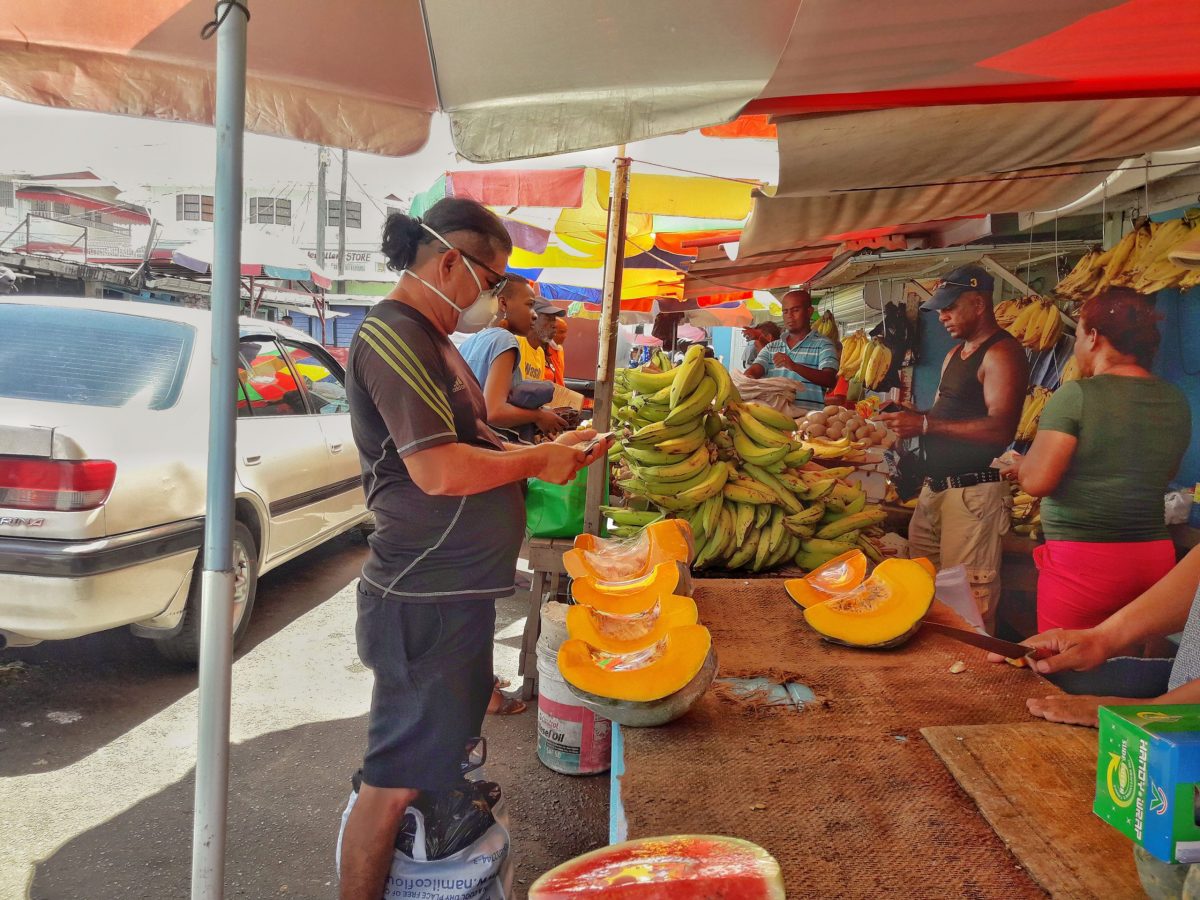A limited survey amongst shoppers in the Bourda and East La Penitence municipal markets just prior to Christmas found consumer dispositions to the pumpkin fruit ranging from an I-can-take-it-or-leave-it posture to revelations that pumpkin is a routine part of their diets. Of the thirty or so persons with whom we spoke during visits to the two markets on different days, we found that more than half of them ate pumpkin “regularly” without being ‘over the moon’ about it. The other half would eat pumpkin from time to time, “if it was selling particularly cheap,” as one Georgetown housewife put it. Others, still, while not having completely removed pumpkin from their culinary options, “don’t really fuss over it,” according to another young woman whom we had watched purchase a thick slice of the brilliant yellow fruit from the side of the road outside the La Penitence Market.

Still, despite the ambivalence, we discerned that one of the genuine attractions that holds pumpkin growers is its combination of high nutritional value and low cultivation costs. Setting aside the acres upon acres of pumpkins cultivated on farms across Guyana for both local consumption and export, there are several modest front and back yards where arbitrarily scattered pumpkin seeds yield their own generous bounty. These factors make pumpkin a great candidate as a functional ingredient in the local food industry.
Over time, the creative acumen of local agro-processors has not only significantly extended the shelf life of the pumpkin but has also extended the range of its uses in food products through the application of drying and powdering to create pumpkin flour that is inhered with considerable culinary flexibility. Our research suggests that studies have been done to optimise the drying method of pumpkin in order to preserve or reduce the loss of its nutritional constituents and colour changes during drying and storage. There has also been research which points to the role that pumpkin powder plays in enhancing the nutritional value of wheat bread by increasing the levels of dietary fiber. Pumpkins are also known to have an abundance of nutrients and antioxidants that promote the body’s immunity against cancer and other diseases.
Persisting with the questioning of our pre-Christmas shoppers, we discovered more. Pumpkins are ‘rated’ amongst local foods primarily because they are “high-yield fruits.” Three farmers with whom we had spoken earlier had confirmed that they were also relatively inexpensive to cultivate. Apart from that they “keep well,” a woman from Sophia who told us that she has grown pumpkins in her yard, said. Here again, our research provided information which suggests that pumpkins can “keep well” for up to three months. Hence the necessity to resort to “drying and powdering techniques.”
Beyond cooking as a stand-alone meal, pumpkin adds value to itself as an ingredient in the manufacture of a range of foods and also serves as a thickener and taste enhancer for soups and stews. It also plays a role as an ingredient in bakery products. Over time, an increasing interest has been paid in pumpkin, simultaneously, by the agriculture, pharmaceutical, food-processing, and body-beauty industries. Brazil and India are among the countries that are using pumpkin for medicinal purposes.
There are also research outcomes which suggest that pumpkin could be an important vegetable “to satisfy children’s needs for carotenoids” which are believed to protect against certain cancers and is considered “a powerful ally against degeneration aspect of aging.”
We emerged from our limited local probe of the pumpkin phenomenon with the conclusion that while there remains a considerable amount of consumer indifference to pumpkin, particularly among children, overall consumer disposition may be shifting on account of a heightening awareness arising out of an enhanced awareness of the importance of healthy eating.
We came away, too, with the view not just that the nutritional value of pumpkin is high, but also that the local health sector as well as the food industry are paying far too little attention to so-called “functional foods.” There are studies that have unearthed antioxidant, anti-diabetic, anti-carcinogenic and anti-fatigue properties in pumpkin pulp. Being a perishable fruit, means that there is a need for inquiries into how its shelf life can be prolonged. Drying is one such method.
Production of pumpkin powder from dried pumpkin slices allows its supplementation into baking products – among others – to enhance its nutritional value. Development of pumpkin wheat composite bread is also a consideration that could be taken more seriously in Guyana. For example, we could pay far more attention to the global focus on increasing the level of incorporation of pumpkin flour into wheaten flour as a value-added initiative.
Guyana’s ambition to become the ‘food basket’ of the region and a high profile exporter of food products has meant that it has had some success in exporting pumpkin to selected countries in the region and further afield. Antigua, Barbados, the British Virgin Islands, Canada, St. Kitts & Nevis, St. Martin, and the United States, are reportedly among our main markets, though export volumes are not consistently available. Pumpkin exports for the year 2018 totaled 480 metric tonnes, the highest export volume over the past five years. With global food shortages and nutrition challenges emerging as hurdles which the international community will have to face in the period ahead, Guyana’s agricultural sector could do worse than focus attention on increasing the levels of pumpkin production whilst the health sector can move in the direction of more aggressing probing of its health and nutritional values.

